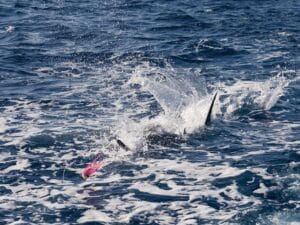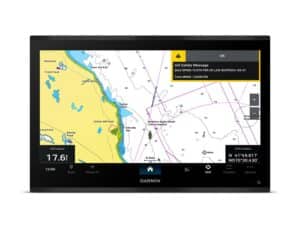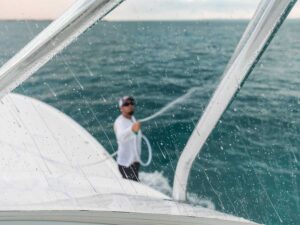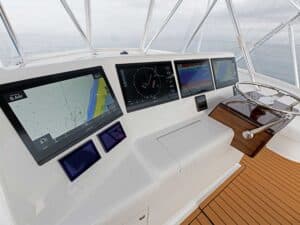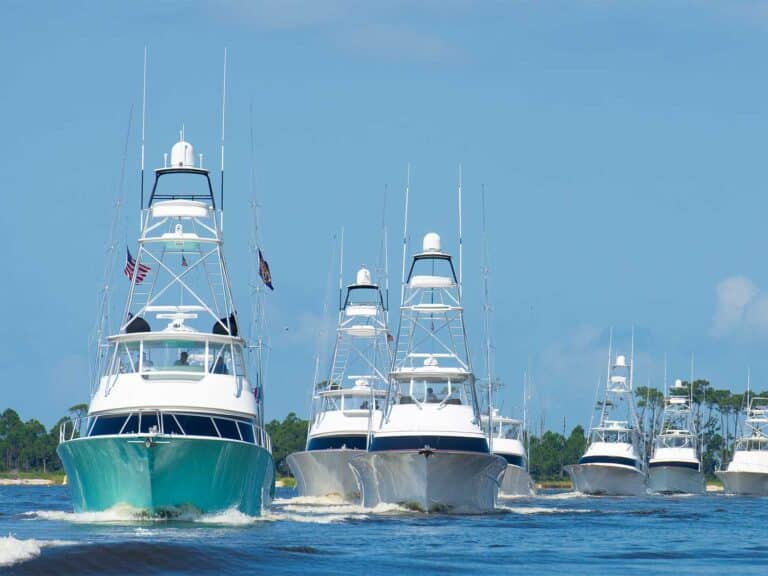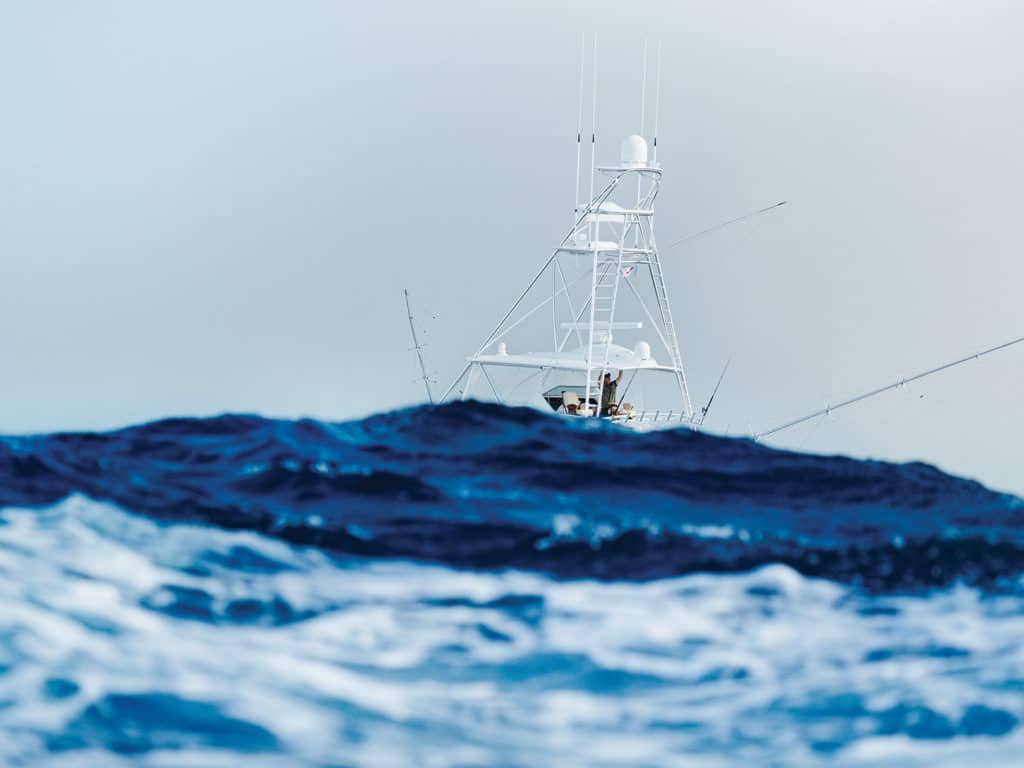
In sport fishing’s recent history, we’ve used tools to look deeper and farther than what we can typically see from the bridge. Using a conventional sounder confirms what the boat has already passed over, and sharp eyes in the tower provide more depth and range for spotting fish before the bite. Both are solid advancements, but what we’ve been missing is 360-degree underwater vision—using sonar gives you the ability to look not only downward, but also outward.
Sonar Types
There are two common sonars: searchlight and omnidirectional. Searchlight sonar works by scanning sections of the water field one at a time in a rotating pattern. Think of this as slow-moving radar with a wide sector between 6 and 24 degrees. This type of sonar gives an increased view over a common sounder, but can be slow to refresh and could miss or lose sections of water, depending on vessel speed, current and the traveling speed of fish. Omnidirectional sonar sends and receives its signals in a 360-degree pattern at each refresh.
For installation, there are a few components that require careful planning. The first is the hull unit. This tube deploys a retractable transducer below the hull of the vessel. Typical sport-fish installations begin with an 8-inch hole cut in the hull, then the tube is glassed in. The transceiver transmits and receives through the transducer, and this data is fed to the processor, where the external interface connections are made: NMEA 0183 data, displays and the control unit. The control unit is the interface for unit operation, and it needs to be accessible. Space is often precious real estate at the helm, so plan for the unit to be easily reachable.
Space, budget and operation are the top three considerations for adding omni sonar. Do you have space for it? Is it in the program’s budget? And will it be used properly to enhance your fishing day, making it worth the money? Many of the captains already using these sonars will tell you it’s an invaluable tool, but there are many other successful fishermen on the water who would argue it isn’t a necessity. But when given the option to have or have not, most would opt for the additional field of vision. What is It?
Omni sonar is different from a traditional sounder in that it allows you to aim the transducer for a full 360-degree view.
Omni sonar is different from a traditional sounder in that it allows you to aim the transducer for a full 360-degree view. Omni sonars are used in fishing applications to evaluate bottom structure and bait movement or to actively chase fish.
The display is in real time, not historical, so understanding how the sonar works and how to control it properly is vital.
The beam is cone-shaped—and as the beam gets farther from the boat, its height increases. This is the vertical beam width. At a range of 1,000 feet, you can cover a vertical column of 200 feet in 360 degrees.
Adjusting the tilt too high can lose surface targets; too low can lose targets near the seafloor. This generally means the user needs to adjust the range and tilt respectively to view different angles of the same area and ultimately pick up targets that could be missed if the unit is left in a fixed range and tilt.
The omni sonar is not a set-it-and-forget-it tool. Normally tasked with running the boat, watching the spread and finding fish, along with the many other distractions and duties, will the captain have time to make constant adjustments to the sonar too? With a sounder, there is a historical view, but unlike a traditional sounder, sonar needs to be actively operated. For some, this isn’t a problem, but for others, it can be incredibly challenging.
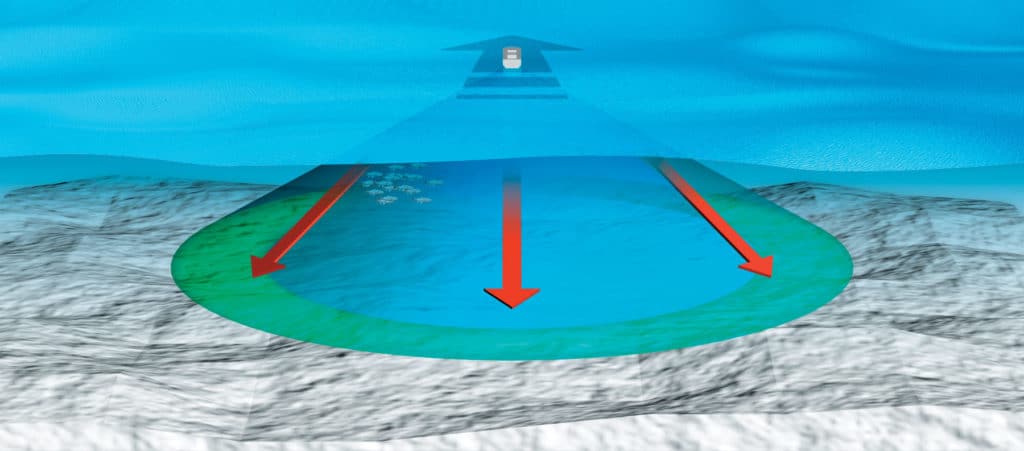
Presenting Your Spread
When using a conventional sounder while fishing around bait, it shows on the display as historical information because the boat has already passed over it. Captains will note the location of the last mark and make a series of passes over the same area, while hoping to stay near enough to the bait that they see it again on the sounder.
When trying to lure predators away from the bait with dredges and teasers, we must draw them into the spread. With the conventional method, we can only hope to keep the spread near the bait by trying to pass over it for visual confirmation, then get back into position to run over it again.
When fishing over bait with a 360-degree sonar view, the approach changes. Now the captain can put the bait on the inside of a turn and allow the spread out of the wash to circle above and around the mark, keeping it presented near the bait below for a much longer time.
Learn how to tune a conventional sounder for optimal results.
Used in open areas and deeper water, the tactic is to scan near the surface and change blind-trolling to active hunting: scanning constantly while looking for marks instead of passing opportunities by. If targets never went under the sounder, you can’t possibly know to steer the boat to get the spread in range of a fish. Learning the omni sonar fishing method can be a complicated process, but if the option is to miss something you never saw or to track something you have a visual confirmation of, take the challenge. Once mastered, your spread becomes even more effective, producing more bites and reducing time spent on a fish that just didn’t want to bite.
Sea conditions and fishing location also can dictate the best methods. As sonar popularity increases, captains will likely find new ways that work with their regional fisheries.
